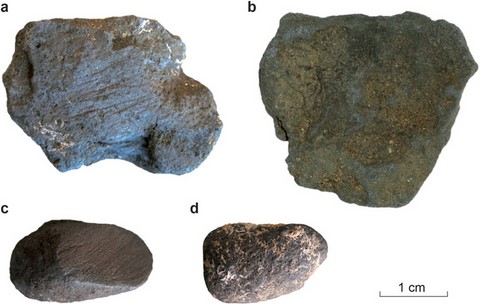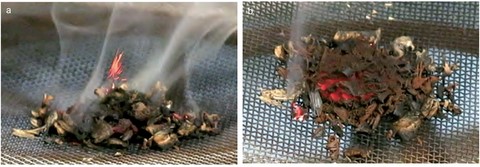Neanderthals used chemical firestarter

The discovery of numerous small black blocs on Mousterian sites revealed that the Neanderthals had a specific use for them - they made it much easier to start a fire.
Scientists from the Dutch universities of Leiden and Delft based themselves on elements found on the site of Pech-de-l’Azé I in the Dordogne region of France. Since François Bordes excavated the site in 1954, several hundred tiny blocs of manganese have been found all over the stratigraphy. However, it is in the layers of the Mousterian that the greatest concentration of these blocs has been found. Bordes had called this level the "level of hearths," because of the abundance of characteristic signs of combustion, which were also identified in recent excavations.
If the site of Pech-de-l'Azé I served as a reference for this study, numerous other Mousterian sites attributed to the Neanderthals yield these little black blocs. « Over 40 European sites have produced colored minerals (red or black), the majority of them dating back to the end of the Middle Paleaolithic, between 60.000 and 40.000 years ago ». As for the site of Pech-de-l’Azé I, dating by OSL (Optically Stimulated Luminescence) gave an average ponderated age of 51,400 years +/- 2000 years.
Paleontologists first thought that these pieces of manganese oxide had been used for their coloring properties. It was generally admitted that these blocs were left over after the coloring of objects, or after having been used as body paint. They were classified as “potential vectors of communication and symbolic expression.”
Yet researchers wondered why the Neanderthals of Pech-de-l’Azé I, if they needed black color for decorative uses, would not have found it simpler to use the charcoal and soot from the fires which they tended on the sites. In fact, the study shows that the Neanderthals used a dioxide of manganese which had to be extracted and transported: the closest source for Pech-de-l’Azé I would have been at Roc-de-Combe, some thirteen kilometers away. The total weight of the little pieces found on the site exceed 750 grams, which excludes a mere chance presence. This oxide was brought there voluntarily.
Moreover, the Neandertals at Pech-de-l’Azé I appeared to have strongly preferred manganese dioxides to the other manganese oxides available in their environment, even though all of the closely related chemicals would have yielded the same color pigment.
In order to explain the presence of these minerals while excluding their use for coloring, scientists looked for others properties of these oxydes of mangenese. (Manganese dioxide is widely used today in dry-cell batteries.)
Scientists rediscovered that manganese dioxide is an efficient fire-starting facilitator: it lowers the temperature of ignition of the wood and markedly incrases the speed of combustion. Thanks to infra-red thermic imagery, it was possible to establish that with the help of manganese dioxide, a fire could be started at a temperature as low as 250°. Wood untreated with mangagese dioxide failed to ignite even at a temperature somewhat above 350°.

Making it faster and easier to light a fire, the use of a powder of manganese dioxide represented a tremendous advantage in everyday life for the Neanderthals. Experiments have shown that a very small quantity of the mineral was needed in order to start the combustion process: only 6% of mineral in relation to the total weight of wood to start the fire.
The microscopic study of the blocs of mineral showed traces of abrasion on some faces. These scratches show that the blocs were rubbed against some kind of a sandstone grinder. Rubbing against an abrasive surface produced a powder. A similar rubbing against human or animal skin would not at all produce the same marks: such traces of abrasion have in fact been found on some of the blocs.
For the Dutch team, all elements are coming together to explain the presence of the blocs of manganese as fire-accelerators. Their study proposes to investigate and analyse similar black blocs from other Mousterian sites. If the presence of pieces of manganese dioxide are found concomitant with hearths sites, it will show that chemical firestarters are a very ancient discovery!
Meanwhile, 400 km away from Pech-de-l'Azé I, at Arcy-sur-Cure in Burgundy, France, the Grotte du Renne (Reindeer Cave) also displays, in its Châtelperronian stratum, traces of manganese dioxide associated with Neanderthal hearths.

